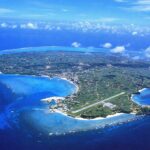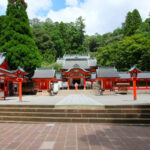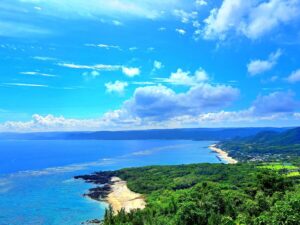
Located in the turquoise waters between Okinawa and Kyushu, Amami Oshima (奄美大島) is a tropical island rich in lush subtropical forests, crystal-clear seas, and vibrant island culture.
Though less famous than Okinawa, Amami offers a more authentic, peaceful, and wild island experience — where pristine nature and deep-rooted traditions coexist.
In 2021, Amami Oshima was recognized as a UNESCO World Natural Heritage Site, confirming its status as one of Japan’s ecological treasures.
Contents
A Quick Overview
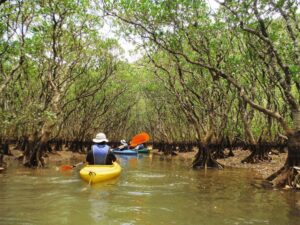
-
Location: Kagoshima Prefecture, between Okinawa and Kyushu
-
Size: About 712 km², Japan’s second-largest remote island after Sado
-
Population: Around 60,000 people
-
Climate: Subtropical, warm year-round — average temperatures range from 17°C (63°F) in winter to 30°C (86°F) in summer
-
Access: 1 hour by plane from Kagoshima or 2 hours from Tokyo (direct flights available)
Natural Beauty and UNESCO Heritage
Amami Oshima’s most striking feature is its untamed natural environment — dense rainforests, mangrove rivers, coral reefs, and rare wildlife found nowhere else in the world.
In July 2021, Amami Oshima and nearby islands were inscribed as UNESCO World Natural Heritage Sites, recognized for their unique biodiversity and high conservation value.
Highlights of Amami’s Nature:
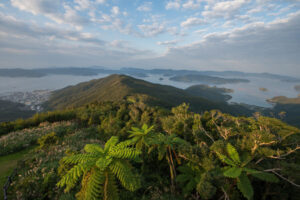
-
Amami Gunto National Park: Spanning across mountains, mangroves, and coastlines.
-
Amami Mangrove Forests (Sumiyo River): Japan’s second largest mangrove area, best explored by kayak or canoe.
-
Kinsakubaru Virgin Forest: A subtropical jungle home to giant ferns and endemic species.
-
Mt. Yuwandake: The island’s highest peak, offering panoramic views of forests and the ocean.
Amami is often described as “a miniature version of Okinawa, before it became touristy.”
Unique Wildlife
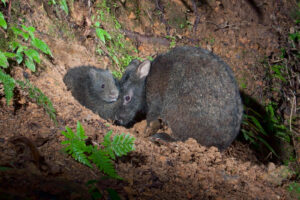
Because of its isolation, Amami is home to species found nowhere else on Earth.
Some are ancient survivors that have existed since before Japan’s main islands formed.
Notable endemic species include:
-
Amami Rabbit (Amami no Kuro Usagi): A rare “living fossil” species found only on Amami and Tokunoshima.
-
Amami Habu (Venomous Snake): A local viper; keep distance but it’s rarely encountered.
-
Lidth’s Jay (Ruri-kakesu): A beautifully colored blue-and-brown bird, symbol of Amami.
-
Amami Ishikawa’s Frog: A bright green frog often seen near forest streams.
Many eco-tours offer guided night walks to safely observe these unique animals in their natural habitat.
Beaches and Ocean Adventures
Amami Oshima’s coastline is breathtaking — a mix of hidden coves, coral reefs, and calm lagoons. The sea’s color, known locally as “Amami Blue,” is famous for its clarity and depth.
Top Beaches:
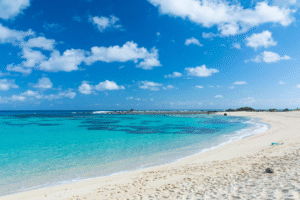
-
Tomori Beach: Known for its white sand and shallow turquoise waters — perfect for swimming and snorkeling.
-
Ohama Seaside Park: Easily accessible from Naze town, ideal for families and picnics.
-
Kurasaki Beach: Great for diving, coral observation, and sunsets.
-
Yadori Beach (Setouchi): A serene, less crowded southern beach surrounded by forest.
Activities:
-
Snorkeling and scuba diving among coral reefs
-
Sea kayaking through mangrove rivers
-
Stand-up paddleboarding and fishing
-
Whale watching (January–March)
-
Night kayaking under the stars
Culture and Traditions
Amami Oshima has a distinct culture shaped by centuries of exchange between Japan and the Ryukyu Kingdom (Okinawa).
Its dialect, music, and crafts reflect a unique identity different from both mainland Japan and Okinawa.
Traditional Music:

Amami’s soulful folk songs, known as “Shima-uta (island songs)”, are accompanied by the Sanshin, a three-stringed instrument covered in snakeskin. The songs often express gratitude to nature and the sea.
Tsumugi Silk Weaving:
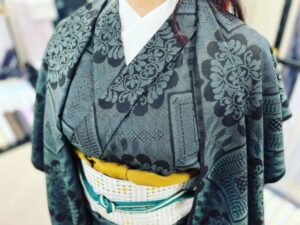
The island is world-famous for Oshima Tsumugi (大島紬), a high-quality silk textile dyed with mud and plant extracts. It’s used for kimono fabric and takes months to produce by hand — a craft passed down for generations. Visitors can try weaving or dyeing at local studios.
Local Festivals:
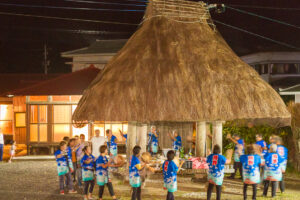
-
Hachigatsu Odori (August Dance): Traditional Bon festival with drumming, singing, and dancing through villages.
-
Harvest and Sea Blessing Ceremonies: Ancient rituals to thank the gods for good fortune and safety at sea.
Local Cuisine
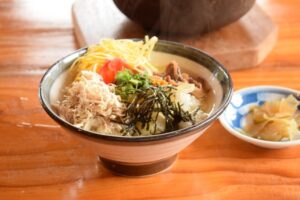
Amami’s food is simple, flavorful, and full of local ingredients from land and sea.
Must-try dishes:
-
Keihan (Chicken Rice): A local specialty — shredded chicken, pickles, egg, and broth poured over rice.
-
Fresh sashimi and grilled local fish.
-
Goya (bitter melon) and island vegetables.
-
Brown sugar sweets and kokutō shōchū, a local spirit made from brown sugar.
Many small restaurants and cafes along the coast serve homemade meals using fresh island produce and seafood.
Top Things to Do
-
Kayak through the Mangrove Forests – peaceful and beginner-friendly.
-
Join a Night Safari Tour – spot rare animals like the Amami Rabbit.
-
Relax at Tomori Beach – one of Japan’s most beautiful beaches.
-
Learn Oshima Tsumugi Weaving – experience traditional craftsmanship.
-
Hike Mt. Yuwandake – for unforgettable island views.
-
Explore Setouchi Town – charming fishing ports and local life.
-
Snorkel or Dive at Kurasaki Beach – coral reefs and sea turtles await.
Best Time to Visit
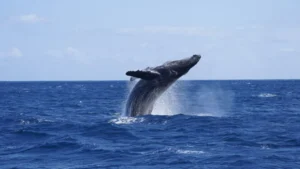
-
Spring (March–May): Comfortable temperatures, ideal for hiking and exploring.
-
Summer (June–September): Best for beach activities and marine sports (note: typhoon season peaks in August).
-
Autumn (October–November): Fewer tourists, clear skies, and calm seas.
-
Winter (December–February): Warm and quiet; perfect for nature walks and whale watching.
Access and Transportation
By Air:
-
From Tokyo (Haneda) – about 2 hours 10 minutes (direct flights by JAL, ANA, or Skymark)
-
From Osaka (Itami/Kansai) – about 1 hour 30 minutes
-
From Kagoshima – about 1 hour
By Ferry:
-
Ferries from Kagoshima (about 11–12 hours) or Okinawa (about 13 hours).
Getting Around the Island:
-
Rent a car – essential for exploring freely.
-
Buses run between main towns but are infrequent.
-
Taxis are available but costly for long distances.
Accommodation

Amami offers a wide range of stays:
-
Beach resorts and boutique hotels – for comfort and ocean views.
-
Guesthouses and hostels – ideal for budget travelers.
-
Traditional minshuku inns – for a homely experience with local food.
-
Eco-lodges in the forest – for a sustainable, nature-immersive stay.
Popular areas to stay include Naze (the main town), Tatsugō, and Setouchi in the south.
Practical Information
-
Language: Japanese (English not widely spoken, but locals are friendly and helpful)
-
Currency: Japanese Yen (ATMs available in major towns)
-
Wi-Fi: Available in hotels, airports, and major cafes
-
Driving: International Driving Permit required for rental cars
-
Cultural Note: Greet locals with a smile and gentle tone — Amami people are known for their warmth and hospitality.
Why You Should Visit Amami Oshima

Amami Oshima remains one of Japan’s last hidden island paradises — untouched, authentic, and deeply spiritual.
Here, you can kayak through mangrove rivers in the morning, dive into coral reefs at noon, and listen to traditional island songs under a sky full of stars.
It’s not just a destination — it’s a journey into Japan’s natural heart and island soul.
Related articles
Official Website
https://goontoamami.jp/en/amamiisland/
Accommodation sites
Agoda
